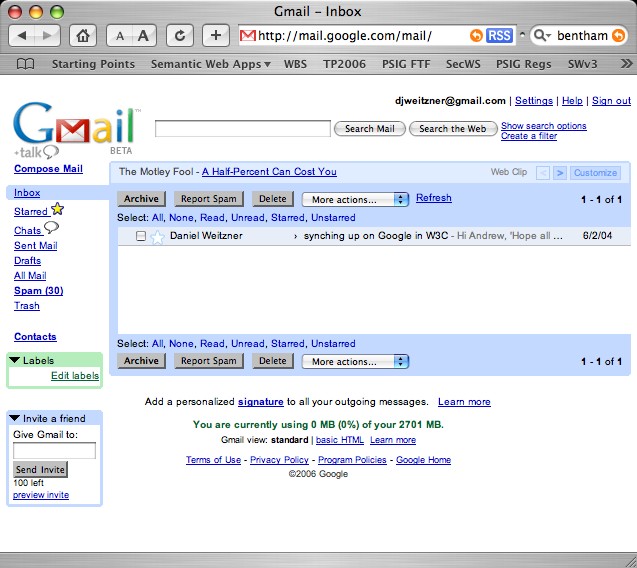Privacy Challenges in the Web's first decade
 |
 |
National Science Foundation
Cybertrust PI meeting29-30 January 2007
Atlanta, Georgia
Daniel J. Weitzner
Decentralized Information
Group
MIT Computer Science and Artificial Intelligence Laboratory
These slides: http://dig.csail.mit.edu/2007/Talks/0129-beyond-secrecy/
1. The advancing privacy challenge
2. Assuming state-of-the art research succeeds, then what...
3. Aligning technology research agenda with privacy's progress
 |
 |
Goal: construct data base protocol that limits information access according to a formal definition of privacy
Privacy Definition: indistinguishability of the individual from the community
Method: measures epsilon-indistinguishability of a database query transcript
Differential Privacy, Cynthia Dwork, 33rd International Colloquium on Automata, Languages and Programming, ICALP 2006, Part II, pp. 1–12, 2006.
k-anonymity work
A privacy-safe zone: Privacy sensitive data mining establishes a boundary, which, if respected, assures no privacy risk to the individual.
question 1 - requires new system design
question 2 - requires new policy making in response to technical change
Historical foundation:
"Ways may some day be developed by which the Government, without removing papers from secret drawers, can reproduce them in court, and by which it will be enabled to expose to a jury the most intimate occurrences of the home.... Can it be that the Constitution affords no protection against such invasions of individual security?"Olmstead v. United States, 277 U.S. 438, 467 (1928) (Brandeis, J., dissenting)
Modern response:
It would be foolish to contend that the degree of privacy secured to citizens by the Fourth Amendment has been entirely unaffected by the advance of technology.... Where, as here, the Government uses a device that is not in general public use, to explore details of the home that would previously have been unknowable without physical intrusion, the surveillance is a “search” and is presumptively unreasonable without a warrant. "Kyllo v. United States. 533 U.S. 27 (2001) (Scalia, J.)
"[T]he law must advance with the technology to ensure the continued vitality of the Fourth AmendmentElectronic Communications Privacy Act legislative history, Senate Report, p.5
Communications Technology |
Crime | 4A trigger |
4A protection | |
| 1928 | Early telephone | Prohibition | Castle: Physical -- property/trespass (Olmstead) | none b/c no trespass |
| 1968 | Mass market phones | Gambling/Organized Crime | People not places (Katz) | Congress enacts guidance of Katz: Probable cause, limited class of crimes, after the fact inventory |
| 1984/6 | Store & forward/email | [pre-emptive strike by technophiles] | Activity not medium | ECPA: email gets status of 1st class mail vs. 3rd party business records |
| 1994 | Transactional records | Global, digital communications | Power to reveal personal information vs. owner | judicial supervision for transactional records access |
| 2007 Today |
World Wide Web and data mining | Terrorism | People not information | ?? |
consider:

This work is licensed under a Creative Commons
Attribution-NonCommercial-NoDerivs 2.5 License.